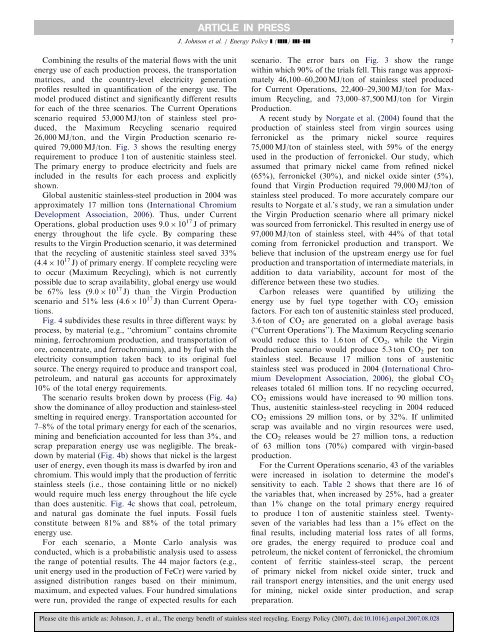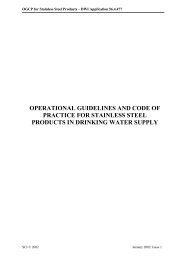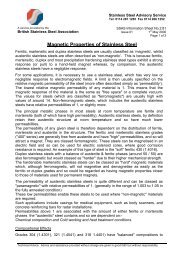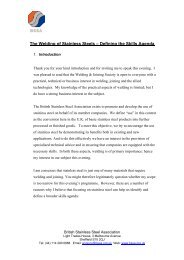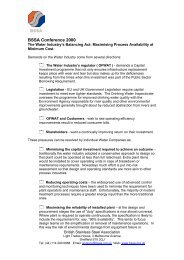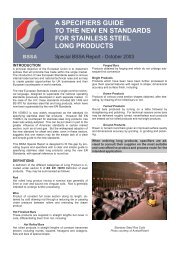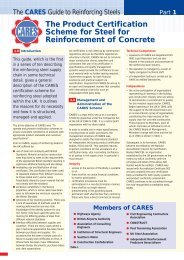The energy benefit of stainless steel recycling - British Stainless ...
The energy benefit of stainless steel recycling - British Stainless ...
The energy benefit of stainless steel recycling - British Stainless ...
Create successful ePaper yourself
Turn your PDF publications into a flip-book with our unique Google optimized e-Paper software.
ARTICLE IN PRESS<br />
J. Johnson et al. / Energy Policy ] (]]]]) ]]]–]]] 7<br />
Combining the results <strong>of</strong> the material flows with the unit<br />
<strong>energy</strong> use <strong>of</strong> each production process, the transportation<br />
matrices, and the country-level electricity generation<br />
pr<strong>of</strong>iles resulted in quantification <strong>of</strong> the <strong>energy</strong> use. <strong>The</strong><br />
model produced distinct and significantly different results<br />
for each <strong>of</strong> the three scenarios. <strong>The</strong> Current Operations<br />
scenario required 53,000 MJ/ton <strong>of</strong> <strong>stainless</strong> <strong>steel</strong> produced,<br />
the Maximum Recycling scenario required<br />
26,000 MJ/ton, and the Virgin Production scenario required<br />
79,000 MJ/ton. Fig. 3 shows the resulting <strong>energy</strong><br />
requirement to produce 1 ton <strong>of</strong> austenitic <strong>stainless</strong> <strong>steel</strong>.<br />
<strong>The</strong> primary <strong>energy</strong> to produce electricity and fuels are<br />
included in the results for each process and explicitly<br />
shown.<br />
Global austenitic <strong>stainless</strong>-<strong>steel</strong> production in 2004 was<br />
approximately 17 million tons (International Chromium<br />
Development Association, 2006). Thus, under Current<br />
Operations, global production uses 9.0 10 17 J <strong>of</strong> primary<br />
<strong>energy</strong> throughout the life cycle. By comparing these<br />
results to the Virgin Production scenario, it was determined<br />
that the <strong>recycling</strong> <strong>of</strong> austenitic <strong>stainless</strong> <strong>steel</strong> saved 33%<br />
(4.4 10 17 J) <strong>of</strong> primary <strong>energy</strong>. If complete <strong>recycling</strong> were<br />
to occur (Maximum Recycling), which is not currently<br />
possible due to scrap availability, global <strong>energy</strong> use would<br />
be 67% less (9.0 10 17 J) than the Virgin Production<br />
scenario and 51% less (4.6 10 17 J) than Current Operations.<br />
Fig. 4 subdivides these results in three different ways: by<br />
process, by material (e.g., ‘‘chromium’’ contains chromite<br />
mining, ferrochromium production, and transportation <strong>of</strong><br />
ore, concentrate, and ferrochromium), and by fuel with the<br />
electricity consumption taken back to its original fuel<br />
source. <strong>The</strong> <strong>energy</strong> required to produce and transport coal,<br />
petroleum, and natural gas accounts for approximately<br />
10% <strong>of</strong> the total <strong>energy</strong> requirements.<br />
<strong>The</strong> scenario results broken down by process (Fig. 4a)<br />
show the dominance <strong>of</strong> alloy production and <strong>stainless</strong>-<strong>steel</strong><br />
smelting in required <strong>energy</strong>. Transportation accounted for<br />
7–8% <strong>of</strong> the total primary <strong>energy</strong> for each <strong>of</strong> the scenarios,<br />
mining and beneficiation accounted for less than 3%, and<br />
scrap preparation <strong>energy</strong> use was negligible. <strong>The</strong> breakdown<br />
by material (Fig. 4b) shows that nickel is the largest<br />
user <strong>of</strong> <strong>energy</strong>, even though its mass is dwarfed by iron and<br />
chromium. This would imply that the production <strong>of</strong> ferritic<br />
<strong>stainless</strong> <strong>steel</strong>s (i.e., those containing little or no nickel)<br />
would require much less <strong>energy</strong> throughout the life cycle<br />
than does austenitic. Fig. 4c shows that coal, petroleum,<br />
and natural gas dominate the fuel inputs. Fossil fuels<br />
constitute between 81% and 88% <strong>of</strong> the total primary<br />
<strong>energy</strong> use.<br />
For each scenario, a Monte Carlo analysis was<br />
conducted, which is a probabilistic analysis used to assess<br />
the range <strong>of</strong> potential results. <strong>The</strong> 44 major factors (e.g.,<br />
unit <strong>energy</strong> used in the production <strong>of</strong> FeCr) were varied by<br />
assigned distribution ranges based on their minimum,<br />
maximum, and expected values. Four hundred simulations<br />
were run, provided the range <strong>of</strong> expected results for each<br />
scenario. <strong>The</strong> error bars on Fig. 3 show the range<br />
within which 90% <strong>of</strong> the trials fell. This range was approximately<br />
46,100–60,200 MJ/ton <strong>of</strong> <strong>stainless</strong> <strong>steel</strong> produced<br />
for Current Operations, 22,400–29,300 MJ/ton for Maximum<br />
Recycling, and 73,000–87,500 MJ/ton for Virgin<br />
Production.<br />
A recent study by Norgate et al. (2004) found that the<br />
production <strong>of</strong> <strong>stainless</strong> <strong>steel</strong> from virgin sources using<br />
ferronickel as the primary nickel source requires<br />
75,000 MJ/ton <strong>of</strong> <strong>stainless</strong> <strong>steel</strong>, with 59% <strong>of</strong> the <strong>energy</strong><br />
used in the production <strong>of</strong> ferronickel. Our study, which<br />
assumed that primary nickel came from refined nickel<br />
(65%), ferronickel (30%), and nickel oxide sinter (5%),<br />
found that Virgin Production required 79,000 MJ/ton <strong>of</strong><br />
<strong>stainless</strong> <strong>steel</strong> produced. To more accurately compare our<br />
results to Norgate et al.’s study, we ran a simulation under<br />
the Virgin Production scenario where all primary nickel<br />
was sourced from ferronickel. This resulted in <strong>energy</strong> use <strong>of</strong><br />
97,000 MJ/ton <strong>of</strong> <strong>stainless</strong> <strong>steel</strong>, with 44% <strong>of</strong> that total<br />
coming from ferronickel production and transport. We<br />
believe that inclusion <strong>of</strong> the upstream <strong>energy</strong> use for fuel<br />
production and transportation <strong>of</strong> intermediate materials, in<br />
addition to data variability, account for most <strong>of</strong> the<br />
difference between these two studies.<br />
Carbon releases were quantified by utilizing the<br />
<strong>energy</strong> use by fuel type together with CO 2 emission<br />
factors. For each ton <strong>of</strong> austenitic <strong>stainless</strong> <strong>steel</strong> produced,<br />
3.6 ton <strong>of</strong> CO 2 are generated on a global average basis<br />
(‘‘Current Operations’’). <strong>The</strong> Maximum Recycling scenario<br />
would reduce this to 1.6 ton <strong>of</strong> CO 2 , while the Virgin<br />
Production scenario would produce 5.3 ton CO 2 per ton<br />
<strong>stainless</strong> <strong>steel</strong>. Because 17 million tons <strong>of</strong> austenitic<br />
<strong>stainless</strong> <strong>steel</strong> was produced in 2004 (International Chromium<br />
Development Association, 2006), the global CO 2<br />
releases totaled 61 million tons. If no <strong>recycling</strong> occurred,<br />
CO 2 emissions would have increased to 90 million tons.<br />
Thus, austenitic <strong>stainless</strong>-<strong>steel</strong> <strong>recycling</strong> in 2004 reduced<br />
CO 2 emissions 29 million tons, or by 32%. If unlimited<br />
scrap was available and no virgin resources were used,<br />
the CO 2 releases would be 27 million tons, a reduction<br />
<strong>of</strong> 63 million tons (70%) compared with virgin-based<br />
production.<br />
For the Current Operations scenario, 43 <strong>of</strong> the variables<br />
were increased in isolation to determine the model’s<br />
sensitivity to each. Table 2 shows that there are 16 <strong>of</strong><br />
the variables that, when increased by 25%, had a greater<br />
than 1% change on the total primary <strong>energy</strong> required<br />
to produce 1 ton <strong>of</strong> austenitic <strong>stainless</strong> <strong>steel</strong>. Twentyseven<br />
<strong>of</strong> the variables had less than a 1% effect on the<br />
final results, including material loss rates <strong>of</strong> all forms,<br />
ore grades, the <strong>energy</strong> required to produce coal and<br />
petroleum, the nickel content <strong>of</strong> ferronickel, the chromium<br />
content <strong>of</strong> ferritic <strong>stainless</strong>-<strong>steel</strong> scrap, the percent<br />
<strong>of</strong> primary nickel from nickel oxide sinter, truck and<br />
rail transport <strong>energy</strong> intensities, and the unit <strong>energy</strong> used<br />
for mining, nickel oxide sinter production, and scrap<br />
preparation.<br />
Please cite this article as: Johnson, J., et al., <strong>The</strong> <strong>energy</strong> <strong>benefit</strong> <strong>of</strong> <strong>stainless</strong> <strong>steel</strong> <strong>recycling</strong>. Energy Policy (2007), doi:10.1016/j.enpol.2007.08.028


